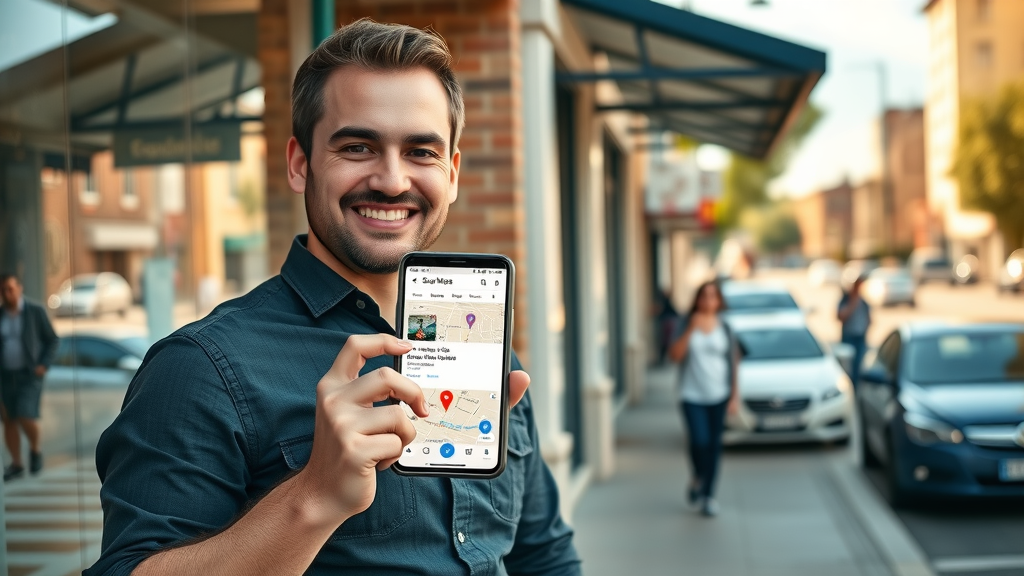Did you know that over 80% of consumers research products online before buying ? In today’s digital-first world, if your small business online marketing isn’t front-and-center, you could be invisible to most of your customers. This guide will show you exactly how to stand out, attract more leads, and grow your business in 2024 using proven online marketing strategies. Discover the secrets that leading entrepreneurs use to gain the competitive edge—and learn how you can apply them, step by step, no matter your budget or industry.
- How to identify and connect with your target audience
- Proven digital marketing strategies for growth
- Optimizing your online presence for maximum visibility
- Choosing the best social media and email marketing tools
- Measuring ROI and adapting to the latest trends
Why Small Business Online Marketing Is Paramount in 2024
Small business online marketing is more than a buzzword—it's a requirement for survival and growth in 2024. As customer expectations shift toward instant information, social proof, and convenience, businesses of all sizes need a robust digital presence. A strong online marketing strategy allows small businesses to compete with large brands, reach potential customers at every stage of the buyer’s journey, and convert that visibility into real sales. Relying solely on walk-in traffic or word-of-mouth is no longer enough; your prospects are searching for your products or services online, comparing options, and reading reviews before making their decisions.
Below, you'll find a photorealistic visual of small business owners collaborating in a modern, vibrant workspace—demonstrating the collaborative, innovative spirit necessary for successful digital marketing in today’s marketplace.

"Over 80% of consumers research products online before buying. If your small business online marketing is weak, you're missing the majority of your audience."
Understanding Your Target Audience for Small Business Online Marketing
At the core of any successful small business online marketing plan is a deep understanding of your target audience. Who are your ideal customers? What challenges do they face? Where do they spend time online? By creating detailed customer personas, small businesses can tailor their digital marketing strategies—such as content marketing, email marketing, or advertising—to address unique needs and behavior patterns. This approach not only boosts the effectiveness of your marketing budget but also ensures higher engagement rates across social media platforms and search engines alike.
To start, gather information through customer surveys, feedback, analytics, and social listening. Identify demographic factors, pain points, and the triggers that lead to purchase decisions. Use this data to segment your email list and personalize every interaction. The more you know about your target audience, the more precisely you can fine-tune your content marketing, promotions, and customer support responses—powerfully increasing your ROI.

How Small Businesses Build an Unstoppable Online Presence
A strong online presence forms the backbone of modern small business online marketing. Small businesses must create and maintain up-to-date profiles on relevant social media platforms, claim business listings on Google and other directories, and publish authoritative, keyword-rich website content. A comprehensive approach not only increases your visibility in search engine results but also boosts credibility among potential customers. Investing in local search engine optimization ensures your business surfaces ahead of competitors in local searches, making you the go-to option in your community.
Consistency is key—update your online profiles with accurate contact details, post regularly to social media, and monitor reviews. Responding to comments and feedback promptly shows potential customers you value engagement and customer support. All these efforts signal a strong online presence, essential for driving business growth and outpacing the competition in the digital arena.
Key Benefits of Digital Marketing for Small Businesses
Digital marketing opens a world of opportunities for small businesses, providing cost-effective solutions to reach a vast audience. With tools like social media marketing, email campaigns, and content marketing, businesses can target specific consumer segments, track responses in real time, and adjust campaigns on the fly. The ability to measure every marketing effort ensures resources are spent wisely, maximizing the impact of your marketing budget.
Additionally, digital marketing enables small businesses to build relationships beyond location constraints. A well-executed digital marketing strategy can increase website traffic, strengthen your brand identity, and generate qualified leads—transforming prospects into loyal customers. This agile, data-driven approach helps small businesses grow faster and steadier in competitive industries where every customer counts.
Digital Marketing Strategies That Boost Small Business Growth
To grow your business online, it’s crucial to adopt multifaceted digital marketing strategies. A mix that includes search engine optimization, content marketing, and savvy use of multiple social media platforms ensures your message reaches potential customers wherever they are. Effective small business online marketing often starts with keyword research, which guides everything from blog topics to ad campaigns and social posts.
Consider running targeted PPC campaigns, crafting conversion-optimized landing pages, or launching influencer collaborations to expand reach. Video marketing, live webinars, and interactive content can also engage your audience longer, increasing both brand awareness and time spent with your digital resources. Monitoring analytics lets you see what’s working, allowing you to refine tactics for even greater returns.
Small Business Marketing Efforts: ROI and Measurement
Measuring the return on your digital marketing efforts is vital for sustainable success. Tools like Google Analytics, Facebook Insights, and email campaign dashboards deliver detailed metrics on website traffic, email open rates, and ad conversions. By setting KPIs (Key Performance Indicators), small businesses can evaluate which marketing strategies drive results and where to improve.
Track metrics such as cost-per-lead, customer acquisition cost, and lifetime value to ensure your marketing investments are generating real business growth. Continuous measurement empowers small businesses to pivot marketing strategies, focus on top-performing channels, and scale what works best—all while keeping the marketing budget efficient and effective.
Comparison of Digital Marketing Channels for Small Business Online Marketing
| Channel | Cost | Best For | Typical ROI |
|---|---|---|---|
| SEO (Search Engine Optimization) | Medium | Long-term visibility, local discoverability | High (over time) |
| Social Media Marketing | Low - Medium | Brand awareness, customer engagement | Moderate to High |
| Email Marketing | Low | Customer retention, repeat sales | Very High |
| PPC Advertising | High | Fast lead generation | Variable (depends on optimization) |
| Content Marketing | Medium | Thought leadership, SEO, nurturing leads | High (compounds over time) |
Crafting a Winning Digital Marketing Strategy for Small Business Online Marketing
Building a digital marketing strategy that works for your small business starts with clear goals and a nuanced understanding of your audience. Align your marketing efforts with specific business objectives—such as increasing online sales, generating leads, or growing your email list. Consider the competitive landscape, available resources, and market trends as you map out your approach.
Your marketing strategy should prioritize the channels that offer the highest potential ROI for your industry and audience. For example, highly visual businesses may focus on Instagram or TikTok, while local service providers might emphasize Google Business Profile and search engine optimization. Leverage data and feedback to iterate on your strategy and stay ahead of evolving digital trends.
Setting Clear Marketing Goals for Small Businesses
Every effective digital marketing strategy begins with clear, measurable goals . Whether you aim to increase website visits, sign up more customers for your email list, or boost product sales via social media platforms, goals set the direction for your efforts. Employ the SMART framework: Specific, Measurable, Achievable, Relevant, and Time-bound objectives guide marketing plans and make it easier to gauge success.
For example, rather than “grow my business online,” a SMART goal would be “increase website traffic by 30% in six months.” Such goals help you allocate resources, track progress, and demonstrate impact to stakeholders. When every marketing effort is connected to a strategic aim, it’s easier to achieve scalable, sustainable business growth.

Building a Marketing Budget to Maximize Digital Marketing Efforts
Creating a realistic marketing budget is critical for maximizing your digital marketing efforts. Analyze past campaign data, forecast potential returns, and consider all channels—SEO, social media, content marketing, email campaigns, and paid media platforms. As a small business, start with goals aligned to your capacity and scale incrementally based on performance insights.
Divide your budget among channels according to your audience’s online habits. For instance, if your target audience frequently uses Facebook or Instagram, allocate more resources to paid and organic media marketing there. Reinvest profits from successful campaigns, and always reserve a portion for testing new digital marketing tactics and emerging platforms to future-proof your strategy.
Choosing the Right Social Media Platforms for Small Businesses
Not all social media platforms serve every business equally. Evaluate each platform—Facebook, Instagram, LinkedIn, TikTok, Pinterest, Twitter—based on where your ideal customers are most active and receptive. For B2C brands, visual-driven platforms like Instagram or TikTok may deliver the best engagement, while B2B companies often benefit from LinkedIn or Twitter networking.
Focus your energy and budget on the media platforms that give you the best chance to connect meaningfully with your target audience. Monitor analytics to see which channels grow your email list, spark conversions, or drive web traffic. Consistency across the right channels leads to recognizable branding, a strong online presence, and a measurable business grow trajectory.
How to Strengthen Your Online Presence with Small Business Online Marketing
Your online presence is your digital storefront—make it count. Optimize your website and all digital touchpoints to attract, engage, and convert prospective customers. This requires continuous effort in SEO, user experience, and high-quality content. Effective use of multimedia (images, video, infographics) also enhances engagement and keeps your business top-of-mind for potential buyers.
Strong online presence includes listing your small business on Google Business Profile, local directories, and relevant industry platforms. Responding to online reviews, maintaining consistent NAP (name, address, phone number) information, and updating your website with new products or services signals credibility and encourages repeat visits.
Optimizing Your Website for Search Engine Rankings
Website optimization is at the heart of small business online marketing success. Without technical and on-page SEO, your site risks being hidden in search engine results, no matter how valuable your product or service. Start by researching keywords your target audience uses, optimize page titles, meta descriptions, headers, image alt tags, and ensure your website loads quickly on all devices.
Structure your content around customer questions and search intent. Use internal links to guide visitors to related content, and leverage clear calls-to-action to convert site traffic. Regularly updating your blog and resource sections signals to search engines (and users) that your business is active and trustworthy—boosting your rankings and driving sustainable traffic growth.

"Search engine optimization turns your small business from invisible to unstoppable in your local market."
Local Search Engine Optimization for Small Businesses
Local SEO is a game-changer for small businesses seeking to dominate their neighborhoods. Claim and optimize your Google Business Profile with updated hours, categories, high-quality photos, and real customer reviews. Use local keywords throughout your site content—such as city names or nearby landmarks—to help search engines recognize your relevance for geo-specific searches. Building local citations and getting listed on industry directories also boosts your local ranking power.
Encourage happy clients to leave positive reviews and respond promptly for increased trust with searchers. Add localized content, such as community-specific blog posts or event pages, and embed location maps on your website. These steps ensure your business appears prominently in Google Maps and “near me” search results, driving qualified leads from your own community straight to your storefront or service area.

Utilizing Content Marketing and Blogging to Enhance Online Presence
Content marketing, including consistent blogging, lays the foundation for authority and engagement in small business online marketing. High-quality blog posts address potential customers’ pain points, answer frequently asked questions, and rank for targeted long-tail keywords. Blogs, e-books, infographics, and tutorials provide value while quietly building loyalty and trust.
Content can be repurposed across platforms—shared in email campaigns, as social media posts, or converted into explainer videos—to maximize audience reach. This integrated approach not only enhances your online presence but increases opportunities for inbound links and organic ranking improvements. Ultimately, ongoing publishing keeps your brand top-of-mind and funnels prospects gently toward purchase decisions.
- Clear value proposition and business description
- Easy-to-find contact information (phone, email, address)
- Mobile-responsive design
- Optimized service/product pages with keywords
- Fast-loading site architecture and SSL security
- Testimonials, reviews, and trust signals
- Well-placed calls-to-action and lead forms
- Regularly updated blog or resource section
- Social media links and sharing buttons
Effective Social Media Marketing Strategies for Small Business Online Marketing
Social media is a powerful lever in small business online marketing, enabling you to reach, engage, and convert an audience where they already spend time. Choosing the right platforms and crafting platform-specific content is essential. Integrate paid advertising, influencer partnerships, and direct engagement (such as replying to comments) into your media marketing mix for best results.
Social media lets small businesses humanize their brands and provide responsive customer support. Consistency, authenticity, and tailored content for each social media platform keep your business grow momentum strong and foster a community around your brand.
Top Social Media Platforms for Small Businesses and How to Succeed
Pick platforms that best reflect your brand and reach your target audience. Facebook offers robust ad targeting and is ideal for community-building, while Instagram and TikTok are perfect for visual storytelling and short-form video. LinkedIn is invaluable for B2B lead generation; Twitter excels with timely engagement and customer support.
Success on each platform requires strategic posting—using trending hashtags, participating in conversations, and sharing a blend of promotional, educational, and entertaining content. Harness analytics tools to track which posts perform, then double down on what resonates. Don’t spread too thin: focus on 2–3 social media platforms and make your presence outstanding.

Maximizing Engagement on Media Platforms
To get results from your media marketing, aim for engagement—not just followers. Respond quickly to comments, run interactive polls or contests, and showcase real stories of your business and customers. Use video content, behind-the-scenes clips, and user-generated posts to make your brand feel approachable and authentic.
Tailor your content to platform algorithms and posting times to maximize reach. Consistency builds visibility, while strategic collaborations with micro-influencers can introduce you to new customers efficiently. Engagement signals on media platforms also improve your content’s chances of surfacing in users’ feeds, further expanding your strong online presence.
Integrating Social Media Marketing into Overall Marketing Strategy
Social media marketing shouldn’t operate in a vacuum. Tie your campaigns back to your larger marketing strategy by promoting blog posts, special offers, or event registrations across your channels. Use analytics to track conversions and traffic generated from social posts, and segment your audience based on interests or activity.
Empower your team to repurpose content between your website, email list, and media platforms—creating a seamless brand message across every digital touchpoint. This integration ensures your marketing efforts support each other, delivering improved results and reduced workload through smart automation and cross-promotion.
Leveraging Email Marketing to Grow Your Small Business Online
Email marketing remains one of the highest-ROI tactics for small business online marketing. By building and segmenting your email list, your business can communicate directly with interested prospects and customers, free from algorithm changes or social media platform policies. Email allows you to personalize offers, nurture leads, and drive repeat business—often at a fraction of the cost of paid ads.
The key is to provide value. Share educational content, special promotions, product updates, and exclusive deals that make subscribers feel valued. Use automation to send timely messages—welcome emails, abandon cart reminders, and loyalty incentives—and track results closely to continuously improve your campaigns.
Building and Segmenting Your Small Business Email List
Growing a quality email list starts with offering compelling incentives—discounts, gated resources, free consultations, or contests. Place sign-up forms prominently on your website, checkout pages, social media profiles, and even in physical locations. Always get explicit permission and make it easy to unsubscribe to protect your brand reputation.
Once you have a healthy list, segment your contacts by demographics, purchase history, or engagement level. This allows for targeted messaging and personalized offers, increasing open rates and driving better conversion. Small businesses that invest in robust email list strategies see long-term gains in customer lifetime value and loyalty.
Developing High-Converting Email Campaigns
Craft emails that are clear, relevant, and action-oriented. Start with an attention-grabbing subject line and personalize content as much as possible (such as using the recipient’s first name). Use simple layouts, strong imagery, and a concise message that highlights a single call to action. A/B test subject lines, content length, and send times to optimize engagement and conversion rates.
Make your emails mobile-friendly, as the majority of users check messages on their smartphones. Analyze campaign dashboards to see which messages drive clicks and sales, then replicate the most successful elements in future campaigns. Consistency, value, and personalization are the foundation for email marketing success in the small business landscape.

Email Marketing Tools for Small Businesses
Numerous email marketing platforms make it easy for small businesses to manage mailing lists, design professional newsletters, and automate workflows. Popular options include Mailchimp, Constant Contact, and ConvertKit. Most tools provide pre-built templates, segmentation features, and analytics to help you optimize campaigns for your business goals.
Integrate these platforms with your CRM and e-commerce systems to create seamless experiences for your customers—from welcome emails to post-purchase follow-ups. Investing in the right email marketing tools saves time, reduces errors, and paves the way for effortless scaling as your business grows.
Top Content Marketing Tactics for Small Business Online Marketing
Content marketing propels your brand into the spotlight by delivering valuable information at every customer touchpoint. An effective strategy combines educational blog articles, engaging videos, infographics, downloadable guides, and customer success stories. These tactics not only boost search engine rankings but also nurture leads, build trust, and fortify your online presence.
Content can be amplified through email, shared across social media platforms, or used in paid ads for greater exposure. Regular content production ensures your business remains a go-to authority in your niche and continually attracts fresh prospects looking for insights or solutions.
Blogging Strategies for Small Business Growth
Blogging drives organic traffic, answers customer questions, and establishes your small business as an industry thought leader. Focus on topics relevant to your target audience—industry how-tos, product comparisons, client stories, and local news. Include specific keywords for search engine optimization, and use internal/external links to source authority and bolster rankings.
Promote your posts via social media and email list blasts to extend reach. Invite guest contributors for fresh perspectives and expanded audiences. Track metrics such as unique visitors, time-on-page, and lead conversions to evaluate your blogging ROI and refine your editorial calendar for maximum impact.

Video Marketing for Small Businesses
Video marketing has exploded in popularity, offering small businesses a high-impact avenue to showcase products, explain services, and connect emotionally with viewers. Short product demos, customer testimonials, behind-the-scenes stories, and educational clips work well on social media platforms and your website. Host live Q&A sessions or tutorials to further boost authenticity and engagement.
Repurpose videos as blog content, use them in email drips, or run video ads for highly targeted outreach. Analytical tools on platforms like YouTube and Facebook let you track views, watch times, and engagement, helping you fine-tune your video strategy for stronger results and ROI.
Repurposing Content Across Digital Marketing Channels
Maximize your investment in content creation by strategically repurposing it across multiple digital marketing channels. Convert a comprehensive blog post into a series of social media infographics, slice webinars into short clips for Instagram, or turn FAQs into engaging videos and podcasts. This not only saves time but ensures a unified, omnichannel message for your brand.
With each piece of content tailored by platform, you can reach potential customers in the format they prefer—expanding your online presence while minimizing production costs. A well-oiled repurposing machine keeps the top of your funnel always full and your online marketing efforts highly efficient.
Small Business Online Marketing with Paid Digital Advertising
Paid digital advertising catapults small businesses in front of targeted audiences instantly. Platforms like Google Ads, Facebook Ads, and even TikTok or LinkedIn Ads let you reach people actively searching for or interested in your products or services. Start with a modest marketing budget, test different creatives, and refine your ads using real-time analytics to optimize ROI for your online marketing efforts.
Utilize geo-targeting, retargeting, and interest-based targeting to ensure your advertisements reach those most likely to convert. Combine paid ads with organic SEO and content marketing for a holistic, multi-channel strategy that covers audiences across all stages of the purchasing funnel.
Running Effective PPC and Social Media Ads
Effective pay-per-click (PPC) and social media ad campaigns start with well-researched keywords and compelling visuals. Tailor each ad for its media platform—carousel ads on Facebook, vertical videos on Instagram Stories, or text-driven ads on Google. Monitor performance (click-through rates, conversion rates, cost-per-acquisition) and A/B test headlines, imagery, and offers to improve results continually.
Successful campaigns often combine a mix of remarketing ads—to reach people who have shown interest before—with acquisition campaigns targeting fresh prospects. Integrate strong call-to-actions and streamline your landing pages for conversions to maximize the ROI of every ad dollar spent.
Setting a Marketing Budget for Paid Campaigns
When allocating a marketing budget for paid digital advertising, consider your business goals, average customer lifetime value, and channel costs. Start with a test phase to gauge channel performance and adjust spend toward high-performing platforms. PPC (Search/Display) often requires a higher upfront investment than organic channels but can deliver immediate results—perfect for product launches or competitive industries.
Include room in your budget for creative development, ad testing, and ongoing optimization. Monitor spending regularly to avoid overspending and ensure every dollar furthers your growth objectives. Keep your budget flexible to capitalize on new opportunities and respond to digital trends as they arise.

Measuring Advertising Performance for Small Businesses
Never “set and forget” your ads. Use analytics dashboards provided by ad platforms to track impressions, clicks, conversions, and revenue generated. Set up proper conversion tracking with tools like Google Analytics or Facebook Pixel, and compare ad performance between channels.
Assess which audiences, creatives, and offers deliver the best return on investment—and pause or pivot underperforming campaigns quickly. Data-driven optimization is key to making every advertising dollar go further and achieving real business growth.
Sample Budget Allocation for Small Business Digital Marketing Strategy
| Channel | Percentage of Budget |
|---|---|
| SEO & Website Optimization | 25% |
| Content Marketing | 20% |
| Social Media Marketing | 15% |
| PPC/Display Ads | 20% |
| Email Marketing | 10% |
| Other (video, influencer, experimental) | 10% |
Optimizing Your Marketing Strategies: Analysis, Testing, and Improvement
Continuous improvement is the hallmark of great small business online marketing. Regularly track performance, experiment with new ideas using A/B tests, and use results to make incremental changes. Agile marketing enables small businesses to seize opportunities and outmaneuver larger, slower competitors.
Collect both quantitative and qualitative feedback—review analytics dashboards and solicit customer input. This full-circle approach ensures your digital marketing efforts always align with real-world results and evolving customer needs.
Tracking Digital Marketing Efforts with Analytics
Analytics are the compass for your digital marketing journey. Use Google Analytics, Facebook Insights, and email platform dashboards to understand how visitors discover, engage, and convert on your site. Track sources of traffic, most viewed content, and conversion rates for every channel.
Set up custom dashboards to monitor KPIs tied to your marketing strategy—form completions, phone calls, online purchases, and more. Data collected over time reveals patterns and highlights high-ROI activities, letting you double down on what works and cut out wasted spend.

A/B Testing for Small Business Online Marketing Campaigns
A/B testing is the simplest way to boost marketing performance. Test one element at a time (headline, image, CTA) in your emails, landing pages, or ads to determine what’s most effective. Even small tweaks can yield dramatic improvements in click-through and conversion rates.
Use built-in tools available in most marketing platforms to automate the process and quickly gather statistically significant results. Apply learnings across other campaigns to scale positive outcomes and fine-tune your content marketing for max impact.
How to Adjust Your Marketing Strategies for Maximum ROI
Regularly review performance metrics and adjust your digital marketing strategy for optimal business growth. Shift resources from low-performing to high-performing channels, and repurpose underutilized content into new formats to reach untapped audiences. Solicit customer feedback to address gaps in your content marketing or service approach, ensuring your strategy stays customer-centric and results-driven.
As new trends and technologies emerge, adapt swiftly. Use AI tools for automation, predictive analytics, and personalized marketing at scale. Stay agile to capture new opportunities before competitors do, and let data—not gut instinct—guide every pivot.
Emerging Trends in Small Business Online Marketing
Digital marketing moves fast, and staying ahead means embracing the latest innovations. In 2024, trends like social commerce, AI-powered automation, and immersive media platforms promise to reshape the way small businesses connect with customers. This ongoing evolution empowers nimble companies to compete and thrive, regardless of size or budget.
Watch for new tools, platforms, and tactics that give you an edge—and be ready to experiment as the digital landscape evolves.
Social Commerce for Small Businesses
Social commerce—the ability to sell products directly through social media platforms—removes friction from the buying process. Platforms like Instagram Shop, Facebook Marketplace, and TikTok Shopping let customers browse and purchase without ever leaving the app. Small businesses can benefit from impulse buys, higher engagement, and new revenue streams by quickly activating these features and promoting products across their media marketing campaigns.
Leverage shoppable posts, influencer partnerships, and live-stream sales events for maximum impact. Track conversions with in-app analytics to measure which products and promotions drive the best ROI.
AI Tools in Digital Marketing for Small Businesses
Artificial intelligence is making digital marketing more impactful and accessible than ever. Tools for predictive analytics, automated email campaigns, chatbot-powered customer support, and content creation let small businesses do more with less. AI can segment audiences, optimize ad targeting in real time, and even suggest next steps based on data patterns.
Start small: test a chatbot for answering common queries, or use AI copywriting tools for faster content production. As you become comfortable, scale up your use of AI to streamline digital marketing efforts and unlock new workload efficiencies.

People Also Ask: Answers to Top Questions on Small Business Online Marketing
How do I market my small business online?
Market your small business online by building a professional website, optimizing for search engines , creating value-driven content, and engaging customers on social media platforms relevant to your target audience. Invest in an email list and utilize email marketing for nurturing leads and repeat business. Measure everything using analytics tools, and regularly update your marketing strategies to maximize impact and keep pace with digital trends.
How to do digital marketing for a small business?
Start digital marketing by defining your business goals and understanding your target audience. Focus on SEO to drive organic traffic, set up social media accounts to build brand awareness, and use content marketing (blogs, video, infographics) to answer customer questions. Supplement with paid digital advertising for immediate exposure, and leverage email marketing for ongoing relationship building with your customers. Track KPIs and use feedback to optimize all marketing efforts over time.
Is digital marketing worth it for small businesses?
Absolutely. Digital marketing levels the playing field, providing cost-effective tools and channels for small businesses to reach large audiences, build brand authority, and compete with much larger competitors. With precise targeting, low-barrier entry, and detailed analytics, digital marketing delivers measurable ROI and lasting business growth when done correctly.
What are the 7 C's of digital marketing?
The “7 C’s” of digital marketing are: 1) Customer, 2) Content, 3) Context, 4) Community, 5) Convenience, 6) Cohesion, and 7) Conversion. These principles guide small businesses in creating customer-centric strategies, delivering valuable and targeted content, fostering brand communities on digital platforms, ensuring frictionless user experiences, unifying messaging across channels, and driving real results through conversions.
Frequently Asked Questions on Small Business Online Marketing
What is the most effective digital marketing channel for small businesses?
There’s no single “most effective” channel—it depends on your industry, audience, and goals. For many, a combination of search engine optimization, content marketing, and email marketing provides the best long-term value. Social media marketing and paid ads can deliver quick wins and scale awareness when used strategically.
How often should a small business update its online presence?
Update your online presence at least weekly. Regular content publishing, social media activity, and website refreshes signal to search engines and customers that your business is active, relevant, and trustworthy. Timely updates keep your brand top-of-mind and improve rankings in search results.
Can small businesses compete with larger brands through online marketing?
Yes! Online marketing offers targeting, personalization, and niche authority options that allow small businesses to outmaneuver larger brands. By focusing on unique value, local SEO, and genuine engagement on media platforms, small firms can connect deeply with their target audience and build lasting loyalty.
What budget should a small business allocate for online marketing?
Start by allocating 7–12% of your revenue to online marketing, depending on your industry and growth targets. Spread your marketing budget across SEO, content, social media, paid ads, and email, adjusting based on ongoing ROI. As campaign performance improves and revenue grows, reinvest additional funds for acceleration.
Key Takeaways: Elevate Your Small Business With Strategic Online Marketing
- Focus on understanding your target audience
- Invest in SEO and content marketing
- Leverage social media and email
- Monitor results and adjust strategies
- Stay ahead with new digital trends
Ready to Grow Your Small Business With Online Marketing?
"Need more leads? Let us show you how. Visit https://aileadninjas.com for actionable online marketing solutions designed for small businesses."
Apply these strategies today: set clear goals, focus your marketing efforts, and adapt continually to grow your business and online presence in 2024 and beyond.
 Add Row
Add Row  Add
Add 




Write A Comment